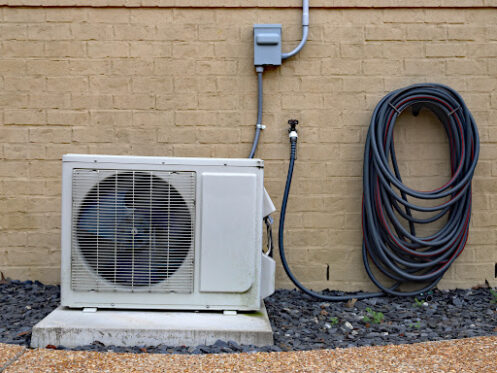Mini-splits are a viable option for homeowners who want to install a new heating and cooling system. With their efficiency and versatility, mini-splits are becoming increasingly popular. However, the question remains: Are they as energy-efficient as they claim to be?
What Are Mini-split Systems, and How Do They Work?
Mini-split systems are ductless heating and cooling systems that provide temperature control for homes. They are becoming increasingly popular because of their energy efficiency, compact size, and ease of installation. The mini-split system is made up of two main components: an outdoor compressor and an indoor air-handling unit.
The outdoor compressor is responsible for compressing and circulating the refrigerant throughout the system. It contains a compressor, a condenser coil, and a fan. The compressor pressurizes the refrigerant, which then flows through the condenser coil, cooled by the fan. Once the refrigerant has been cooled, it is sent back to the indoor unit to absorb heat from the room.
The indoor air-handling unit is installed inside the room or space that needs to be heated or cooled. It consists of an evaporator coil, a fan, and a filter. The evaporator coil is where the refrigerant absorbs heat from the room, and the fan circulates the air through the coil to distribute the conditioned air throughout the space. The filter removes any impurities from the air, such as dust or allergens, before it is distributed into the room.
Mini-split systems work by taking advantage of the natural heat transfer properties of refrigerants. The refrigerant absorbs heat from the air inside the room and then transfers that heat to the outdoor unit, where it is released into the outside air. This process can be reversed to provide heating during the colder months. The system is controlled by a thermostat or remote control, allowing for precise temperature control and energy efficiency. There are several benefits to using a mini-split system that modern homeowners are embracing.
Energy Efficiency
Energy efficiency is achieved through a combination of several factors, including the use of inverter-driven compressors and advanced control systems. Inverter-driven compressors are a key component of mini-split systems. Unlike traditional compressors, which operate at a fixed speed, inverter-driven compressors can vary their speed based on the cooling or heating demand of the space. This means that the compressor can slow down or speed up to match the room’s needs rather than running at full capacity all the time. This allows for more precise temperature control and significant energy savings.
Mini-splits also use advanced control systems for precise temperature control and scheduling. These controls enable users to set the temperature and time of operation, ensuring that the mini-split system only operates when it is needed.
It’s important to note that mini-splits generally have higher SEER ratings than whole-home units. SEER stands for “seasonal energy efficiency ratio,” which is a measure of the system’s cooling output divided by its energy consumption over a cooling season. Mini-splits typically have SEER ratings of 20 or higher, while traditional systems typically have SEER ratings between 13 and 18. The higher SEER ratings of mini-splits can be attributed to their advanced technology and energy-efficient design. This results in lower energy consumption, lower operating costs, and a reduced environmental footprint.
Flexibility in Installation
Unlike traditional HVAC systems that require extensive ductwork to be installed, mini-split systems only require a small hole to be drilled in the wall to connect the indoor and outdoor units. This means they can be installed in almost any location, making them ideal for buildings that cannot accommodate ductwork.
Additionally, mini-split systems come in various sizes, making it easy to find the perfect fit for any space, and they can be used to supplement existing HVAC systems, making them a cost-effective way to increase comfort levels in specific areas of a building without having to replace the entire system.
Better Indoor Air Quality
Mini-splits don’t require ductwork, which reduces the potential for mold, dust, and other allergens to accumulate and circulate throughout the building. With mini-splits, the air is cooled and distributed directly into the room, ensuring the air quality is fresher and cleaner.
Another advantage of mini-split systems is their multi-stage filtration system, which captures dust, pollen, and other pollutants from the air. The filters in these systems are highly efficient, removing even the smallest particles from the air. As a result, people with allergies or respiratory issues can breathe easier and experience fewer symptoms indoors.
Quiet Operations
Mini-split systems are designed to offer a comfortable and peaceful indoor environment, and their quiet operations are a crucial part of this design. The indoor unit of the mini-split system uses advanced technology to minimize noise levels, providing a virtually silent operation. The sound level of the indoor unit is only about 19 decibels, equivalent to the sound of a whisper. This makes the indoor unit perfect for use in quiet spaces, such as bedrooms, libraries, or study rooms, where noise levels must be minimal.
On the other hand, the outdoor unit of the mini-split system, which houses the compressor, is also designed to operate quietly. The sound levels of the outdoor unit are around 50 decibels.
Environmentally Friendly
Mini-splits are designed to cool individual rooms or zones, allowing users only to cool the rooms they use rather than the entire house. This targeted approach to cooling reduces energy waste and helps to decrease carbon emissions, making them an eco-friendlier option. Additionally, mini-split systems use a type of refrigerant less harmful to the environment than the refrigerants used in traditional central air conditioning systems. This refrigerant, called R410A, has a lower global warming potential and does not contain chlorine, which can harm the ozone layer.
Longevity
Mini-split systems are designed with longevity in mind. Unlike traditional HVAC systems, which typically have a lifespan of 10-15 years, mini-split systems can last up to 20 years or more with proper maintenance. The primary reason for this extended lifespan is the lack of ductwork in mini-split systems. Ductwork is prone to leaks and damage, leading to reduced efficiency and increased wear and tear on the system. Mini-split systems have a more straightforward design with fewer moving parts, making them less prone to mechanical breakdowns.
Another factor contributing to mini-split systems’ longevity is their energy efficiency. These systems are designed to use less energy than traditional HVAC systems, which means they don’t have to work as hard to keep your home or business comfortable. This reduced workload translates to less wear and tear on the system, leading to a longer lifespan.
Proper maintenance is crucial to ensure that mini-split systems last as long as possible. Regular cleaning of the indoor and outdoor units, replacing filters, and scheduling annual maintenance inspections by a professional technician can help to keep the system running smoothly and extend its lifespan.
Contact Professionals Today!
At True Climate Heat + Air, we take great pride in providing top-notch plumbing, heating, and cooling services to the residents of the Oklahoma City metro area. Our experienced technicians are available 24 hours a day, seven days a week, to provide emergency services whenever you need them. We also offer air quality services to help improve the air you breathe. Call True Climate Heat + Air today to schedule an appointment or to learn more about our services.


